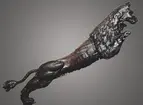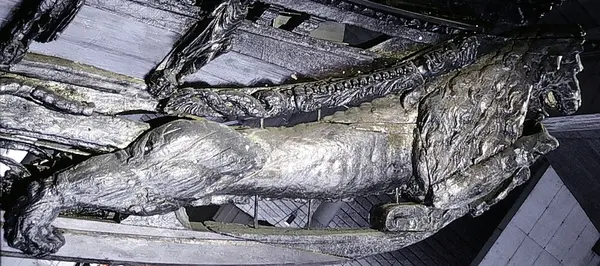Skulpterat lejon återgivet i språng, med vidöppet gap.
Lejonet står på bakbenen, med kroppen riktad snett uppåt och frambenen framsträckta. Svansen hålls i det närmaste rakt utsträckt från bakkroppen. Svansen består egentligen av två svansar som är fästade - förutom vid djurets bakkropp - på var sin sida utmed en balk. Lejonet har tjock man, kraftiga ögonbrynsbågar och yvig svanstopp. Revbenen är tydligt markerade.
Lejonets kropp och huvud är snidade i ett stycke, endast mindre delar av manen och ryggen har kompletterats med separat snidade delar. Fram- och bakben, svansar samt tunga är separat tillverkade. Kropp och huvud är rundskulpterade, medan bakben och svansar har platta och släta baksidor. Frambenen är fastsatta vid kroppen med trädymlingar, medan bakbenen varit fastsatta med spikar. I lejonets gap finns urtag för tungan.
Ländrygg, vänster bakben samt mindre delar av de båda svansarna saknas. Lejonets vänstra bakben är rekonstruerat. Nacken, ovansidan av huvudet samt delar av kroppen är märkta av vattenslitage och sprickbildning.
Lejonets vikt: 450 kg.
Text in English: This is a sculpture of a lion starting his spring on his prey.
The lion is standing on his hind legs with his body at full stretch. His forepaws are held close to his body and his jaws are open. The tail is held almost straight out from its hindquarters. The tail is fastened to the lion''s hindquarters but then divides in order that it can be attached to either side of the beam and can thus be seen on both sides of the ship. The lion has a thick mane, pronounced eyebrows and a tail with a large bushy tuft. The ribs are clearly visible through the skin.
The body and head are one single piece and are carved in the round. Minor additional pieces on the mane and back have been added and the legs, tongue and tails are carved separately. The parts of the rear legs and tails that are closest to the ship are flat and smooth. The forelegs are fastened to the body with treenails, and the rear legs were fastened to the body with iron nails. In the jaws there is a cut-out hole to receive the separately made tongue.
The lumbar region of the back, the left rear leg and small parts of the two tails have not been found. The lion''s left hind leg is reconstructed and the upper side of the lion''s head, its neck and parts of its body are worn by water and cracked.
Weight: 450 kilos.









 ARTIKLAR I WIKIPEDIA
ARTIKLAR I WIKIPEDIA ARTIKLAR I WIKIDATA
ARTIKLAR I WIKIDATA BILDER I WIKIMEDIA COMMONS
BILDER I WIKIMEDIA COMMONS


